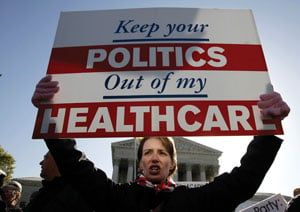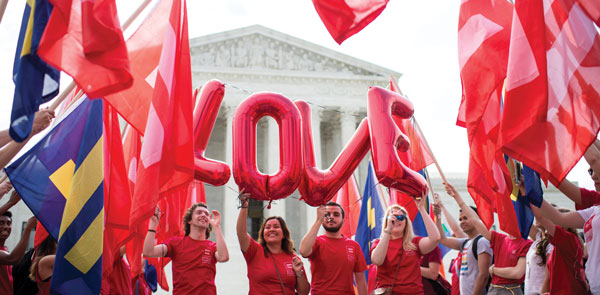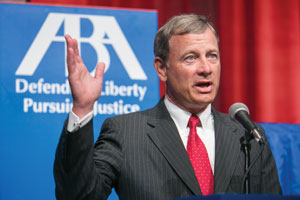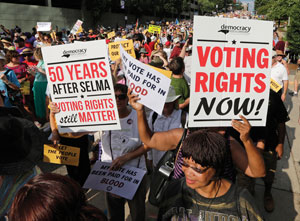John Roberts marks 10 years as chief justice by taking the long view

Illustration by Stephen Webster
Roberts, as he has sometimes done during his just-completed first 10 years as chief justice, managed to please and disappoint both sides of the political spectrum with his votes.
As if scripted by a screenwriter, Roberts wrote the majority opinion for the court in King v. Burwell, which again sided with President Barack Obama’s administration in upholding the president’s signature health care law.
Despite Roberts’ track record as a reliable conservative on many issues, the ACA decision reinforced doubts among many on the political right about his commitment to conservative ideals. Carrie Severino, the chief counsel of the right-leaning Judicial Crisis Network in Washington, D.C., and a former law clerk to Justice Clarence Thomas, says Roberts has been feeding the fears that have existed in the back of conservatives’ minds since his nomination in 2005.
“When the chief justice was nominated, a lot of people like me wanted to be optimistic, but we had concerns,” Severino says. “What we’ve seen over the course of his tenure underscores the dangers of appointing judges without a clear track record of support for the rule of law.”
Meanwhile, in Obergefell v. Hodges, the chief justice surprised some observers by dissenting in the historic decision finding a constitutional right for same-sex marriage. That dissent left progressives believing that Roberts was on the wrong side of history on one of the biggest constitutional questions of the era.
“It’s disappointing that the person who leads the court as chief justice is telling people they can’t vindicate their constitutional rights in court but have to go ask their neighbors to vote on it,” says Elizabeth B. Wydra, the chief counsel for the Constitutional Accountability Center, a liberal legal group in D.C.

AP Photo
Not all the reactions to the widely debated decisions were as partisan.
Jeffrey Rosen, a professor at the George Washington University Law School and president of the National Constitution Center in Philadelphia, takes a more nuanced view. “The health care and marriage equality decisions show Chief Justice Roberts to be entirely constitutionally principled and consistent,” he says.
Rosen observes that Roberts is embracing judicial restraint by showing deference to the choices of Congress in the health care case and state legislatures or voters on the issue of recognizing same-sex marriages. The chief justice, Rosen says, “is embracing a bipartisan view of judicial restraint” based on the idea that the Supreme Court should defer to the political branches.
Whether any of the post-decision assessments bothered the chief justice seems doubtful. Within a matter of days, he was on his way to Japan for 11 days, where he gave a lecture at the University of Tokyo on “the roles of the chief justice” and taught a class at Kyoto University.
“My sense is he has a peace of mind about” the end of the contentious court term, says Judge J. Harvie Wilkinson III of the 4th U.S. Circuit Court of Appeals at Richmond, Virginia, and one of Roberts’ friends. “He has his principles and he is going to state his convictions with respect to each and every case, but he is also able to step back and take the long view,” adds Wilkinson, who worked with Roberts in President Ronald Reagan’s administration. “He knows you can’t please everyone in the job.”
HEALTH CARE AND MARRIAGE
The completion of Roberts’ 10th term as chief justice comes amid an array of interest-group research, scholarly panel discussions and news stories analyzing the Supreme Court’s work over the last decade. The two biggest cases of the last term put a couple of exclamation points on the chief justice’s first 10 years.
Roberts wrote the 6-3 majority decision in King, upholding the Affordable Care Act against the statutory challenge that sought to limit the availability of insurance subsidies to those in states with “exchanges established by the state.” A decision that went the other way might have seriously hobbled the health care law.

Charles Dharapak; AP IMAGES
“In a democracy, the power to make the law rests with those chosen by the people,” the chief justice said in his opinion. “Our role is more confined—‘to say what the law is,’ ” he added, quoting Marbury v. Madison. “That is easier in some cases than in others,” he continued. “But in every case we must respect the role of the legislature and take care not to undo what it has done.”
The criticisms began immediately, starting with an oral dissent from the colleague at his right arm on the bench. “We should start calling this law SCOTUScare,” Justice Antonin Scalia said, referring to the acronym for Supreme Court of the United States. Even the chief justice broke into a grin at that barb.
Outside the court, conservative critics were similarly harsh.
“Chief Justice Roberts has now become a co-conspirator in this executive law-making,” declared the Wall Street Journal editorial page.
And the conservative journal Human Events said Roberts “is morphing into retired Justice David Souter right before our eyes.”
While Roberts may have won points among progressives for that decision, he turned right around and disappointed them in the recent term’s other blockbuster decision, Obergefell, in which he did not sign on to Justice Anthony M. Kennedy’s 5-4 decision finding a right to same-sex marriage in the 14th Amendment.
Marriage has been “a social institution that has formed the basis of human society for millennia—for the Kalahari Bushmen and the Han Chinese, the Carthaginians and the Aztecs,” Roberts said. “But today five lawyers have ordered states to change their definition of marriage. Just who do we think we are? I have no choice but to dissent.”
Roberts, who read his dissent from the bench for the first time, elaborated. “If you are among the many Americans—of whatever sexual orientation—who favor expanding same-sex marriage, by all means celebrate today’s decision,” he said. “Celebrate the achievement of a desired goal. Celebrate the opportunity for a new expression of commitment to a partner. Celebrate the availability of new benefits. But do not celebrate the Constitution. It had nothing to do with it.”

Chief Justice Roberts. Photograph by Kathy Anderson.
The court’s most recent term gave observers plenty to ponder as they were stepping back to assess 10 years of Roberts at the helm of the court. The chief justice declined an interview request to discuss his tenure so far.
Wydra says that while the chief justice’s critics on the right may be blind to it, Roberts “has consistently and quite successfully moved the court in a conservative direction.”
In more than 770 merits decisions since he took office, the chief justice has had the same lone vote as his eight colleagues. But there is consensus among court observers on the cases that are the hallmarks of his time on the court:
• Parents Involved in Community Schools v. Seattle School District No. 1 In his 2007 plurality opinion for a judgment by the court that barred school districts from voluntarily taking race into account for diversity, Roberts issued this infamous line: “The way to stop discrimination on the basis of race is to stop discriminating on the basis of race.” That view was an indication to some that the chief justice had an agenda on race in the law.
Justice Sonia Sotomayor, who hadn’t yet joined the court when that decision came down, took the chief justice to task for his view seven years later in writing a fiery dissent in another case, Schuette v. Coalition to Defend Affirmative Action. She noted that “the way to stop discrimination on the basis of race is to speak openly and candidly on the subject of race, and to apply the Constitution with eyes open to the unfortunate effects of centuries of racial discrimination.”
• Citizens United v. Federal Election Commission Without question, there’s one Supreme Court case from the last 10 years whose effects on national politics continue to reverberate and are being seen in the current—and expensive—presidential primaries: the 2010 decision that struck down limits on independent campaign expenditures by corporations and unions.
Justice Anthony Kennedy wrote the opinion, not Roberts, but the chief justice is credited (or blamed) in some accounts with the behind-the-scenes maneuvering that changed the case from a relatively modest one about an anti-Hillary Clinton campaign film to one that overruled two high court precedents on campaign finance and opened the floodgates of independent spending.
President Obama’s criticism of the decision in his 2010 State of the Union address, with Roberts and other justices sitting just a few feet away, added to the complex relationship between the leaders of the two federal branches. (Obama voted against Roberts’ confirmation, and the flubbed presidential oath between the two men in 2009 didn’t help the relationship much.)
• National Federation of Independent Business v. Sebelius The chief justice joined the court’s liberal bloc in 2012 to uphold the main provisions of the Affordable Care Act under Congress’ taxing authority, even though Roberts agreed with his fellow conservatives that the law could not be sustained under the Constitution’s commerce clause.
Just as he retreated to Japan this summer, Roberts left for the island nation of Malta soon after the NFIB decision. And while Washington pondered reports of bitter recriminations among the court’s conservative bloc that felt Roberts had switched sides to uphold the law, the chief justice quipped that accepting the invitation to the “impregnable island fortress … seemed like a good idea.”

Bill Clark/CQ Roll Call
• Shelby County v. Holder In 2013, Roberts wrote the opinion for a 5-4 court that sharply limited the scope of the Voting Rights Act of 1965 by striking down the coverage formula that determined which states and local jurisdictions had to receive federal approval in advance of any changes in voting.
“Things have changed dramatically” since 1965, Roberts wrote. “Our country has changed, and while any racial discrimination in voting is too much, Congress must ensure that the legislation it passes to remedy that problem speaks to current conditions.”
Critics viewed the decision as the product of a long-held desire by Roberts to rein in the voting rights law.
THE TORTOISE AND THE SCHOOL PLAY
Ideological issues aside, Roberts can be funny on the bench, is often playful in his opinions, has a penchant for history, and sometimes has reason to remind people that he is a middle-aged father and family man.
“His opinions tend to be strongly reasoned,” says Adam Winkler, a law professor at the University of California at Los Angeles. “They’re clear. They’re easy to teach.”
Last year, in Riley v. California, a case in which the court unanimously held that the police had to get a warrant to search the contents of a cellphone, the chief justice’s opinion for eight members of the court went out of its way, with references to “browsing history” and “apps,” to show that the court was not totally unhip when it came to emerging technologies.
In 2011, in a dissent from denial of certiorari joined by Justice Kennedy, Roberts argued that the court should have taken up an obscure case in which Pennsylvania’s highest court had invalidated a drug arrest. The chief justice crafted an introduction to the dissent in the fashion of a hard-boiled detective novel: “North Philly, May 4, 2001. Officer Sean Devlin, Narcotics Strike Force, was working the morning shift. Undercover surveillance. The neighborhood: Tough as a $3 steak,” Roberts wrote.
On New Year’s Eve in 2014, in his year-end report on the federal judiciary—a document even more obscure than any procedural dissent—the chief justice wrote enthusiastically about the introduction of a pneumatic tube system in the court’s new building in 1935. The compressed-air system allowed reporters to zip opinions from the courtroom to waiting colleagues in the press room one floor below.
Roberts’ point was to note that the court was cautious in welcoming new technologies, and that it was preparing for a new, all-electronic filing system. He made reference to the “sturdy bronze tortoises” incorporated into the court’s elaborate exterior lampposts by architect Cass Gilbert, “symbolizing the judiciary’s commitment to constant but deliberate progress in the cause of justice.”
The chief justice has displayed his fondness for history in other ways. Last year, he appeared before the American Bar Association to celebrate the 800th anniversary of the Magna Carta. “American settlers duly incorporated elements of the Great Charter into colonial law,” Roberts said. “When they revolted against George III, they did not view their cause as a fight for novel freedoms, but rather one to preserve liberties they traced to Magna Carta.”
In spring 2014, the chief justice appeared one evening in the courtroom to introduce an author who was addressing the Supreme Court Historical Society about Chief Justice Earl Warren’s extrajudicial work on the commission that investigated the assassination of President John F. Kennedy. Using the courtroom for such events requires the participation of a member of the court who usually provides a polite but concise introduction of the speaker.
Roberts was anything but brief and went on for several minutes about other extrajudicial assignments taken on by previous chief justices, including John Jay, who also served as ambassador to England while a member of the court, and John Marshall, who served for a time both as chief and as acting secretary of state.
“It is hard for me to contemplate the chief justice taking on a second job,” Roberts told the audience that evening in the courtroom. “For me, anyway, the plate has been full enough.”
When the guest speaker, the author James Swanson, proceeded to the lectern, he skipped over the first few pages of his speech. “The chief justice gave part of my talk,” Swanson said with a smile.
That night with the Supreme Court Historical Society underscored another fact about Roberts: Despite having one of the most powerful and demanding jobs in the country, he had other pressing demands as a devoted family man.
The chief justice explained why he had to duck out of the lecture early. “This is the second-hottest ticket in town this evening,” he said. “The hottest ticket in town is an eighth-grade performance of A Midsummer Night’s Dream, which I will be off to shortly. … I have a special relationship to the lead actress in the show, and I can’t miss that, and I’m sure you’d understand.”
Roberts hardly leads a cloistered life and shows up at the hockey games, soccer matches and other extracurricular events of his daughter, Josephine, and son, Jack, who are now in high school. Jane Sullivan Roberts, the chief justice’s wife, is a partner at the legal search firm Major, Lindsey & Africa. She sometimes attends court sessions in the VIP guest box, as she did on the day of her husband’s dissent in the same-sex marriage case.
Carter G. Phillips, a Sidley Austin partner who has argued more Supreme Court cases than any other member of the court’s specialty bar, notes that Roberts is still several years younger, and at a different stage of life, than his immediate predecessors—William H. Rehnquist and Warren E. Burger—were when they presided over the court.
“He’s in an odd situation,” says Phillips, who clerked for Burger and is a longtime friend of the 60-year-old Roberts. “He’s got a life.”
NOT ONE FOR THE LIMELIGHT
In his 10 years on the bench, Roberts has earned a reputation for his courtesy to the lawyers who argue before him. In the courtroom, Roberts is widely known for being more generous to counsel than Rehnquist had been.
“The old chief would interrupt you in the middle of the word if if your time was up,” says Miguel A. Estrada, a Gibson, Dunn & Crutcher partner who has argued many times before the Rehnquist and Roberts courts.
Estrada, who made that remark at a panel on the chief justice’s 10 years in office at this year’s ABA Annual Meeting, does not think Roberts is as strict as his predecessors. “The new chief is a lot more generous with the clock. He might actually let you finish your sentence or give you more time,” he says.
Paul M. Smith, the head of Jenner & Block’s Supreme Court practice, agrees that Roberts has brought a “welcome flexibility based on his experience arguing on the other side of the podium.”
But Smith is one advocate who has felt Roberts’ occasional angry questioning; he and the chief justice had a tense exchange during arguments in a First Amendment case a couple of years ago. “He is certainly a justice who is formidable when he is not on your side,” Smith says.
Off the bench, Roberts rarely gives high-profile public speeches or seeks the limelight, even though several members of the current court have embraced various forms of celebrity, such as Justice Ruth Bader Ginsburg and her “Notorious RBG” fan club, and justices who have written and promoted their own books. It would be hard to imagine Roberts going on the now-defunct Jon Stewart or Stephen Colbert shows on Comedy Central, as Sotomayor did to promote her memoir (not to mention an appearance on Sesame Street).
David J. Garrow, a history professor at the University of Pittsburgh and frequent author on the history of the Supreme Court, says that in his view some of the justices have taken the idea of becoming public figures too far. “I’ve been disappointed that Roberts has not succeeded—and we don’t know how much he has tried—in disciplining his colleagues for participating in public behavior that does not conform with the institution as a judicial one,” Garrow says.
Whether Roberts has tried to rein in any such excesses is indeed unknown. But he does have a rep-utation for caring deeply about perceptions of the court.
THE VERDICT OF HISTORY AWAITS
“He is very much an institutionalist,” says Judge Wilkinson of the 4th Circuit. “When we worked together, he was concerned about the Reagan administration as an institution and the Justice Department as an institution. Today, he is very much concerned about the dignity and integrity of the Supreme Court as an institution.”
In the summer of 2006, after he had completed his first term, Roberts gave an interview to Rosen, the George Washington professor who also wrote widely about the court, that appeared in The Atlantic. It is one of the few ruminative interviews the chief justice has given while in office.
During the interview, the conversation turned to judicial disappointments. “It’s sobering to think of the 17 chief justices; certainly, a solid majority of them have to be characterized as failures,” Roberts said with a rueful smile. “The successful ones are hard to number.”
Rosen asked Roberts to elaborate about why he thought so many chief justices had been failures. Partly, Roberts explained, it was because the powers of the office are not extensive.
“A chief justice’s authority is really quite limited, and the dynamic among all the justices is going to affect whether he can accomplish much or not,” he told Rosen. “There is this convention of referring to the Taney court, the Marshall court, the Fuller court, but a chief justice has the same vote that everyone else has.” As a result, “the chief’s ability to get the court to do something is really quite restrained.”
There is no shortage of observers willing to point out that because Roberts has not fully put his stamp on the court the way Chief Justices Warren, Burger or Rehnquist have, one might call it the “Kennedy court,” after the justice most likely to tilt its balance on divided issues.
Nine years after that interview, Rosen says it’s still premature to say whether Roberts will be remembered as one of the great chief justices. “It is too early to make a final judgment,” he says. “But it is striking that in these polarized times, Chief Justice Roberts is self-consciously trying to help the court rise above politics.”
And, Rosen adds: “He has admirable aspirations, and he still has decades ahead to try to achieve them.”
This article originally appeared in the October 2015 issue of the ABA Journal with this headline: “Supreme Restraint: John Roberts marks 10 years as chief justice by taking the long view.”
Related article:
ABAJournal.com: “Chemerinsky: 10 lessons from Chief Justice Roberts’ first 10 years”
Mark Walsh is a Washington, D.C.-based freelance writer who regularly reports on the Supreme Court for the ABA Journal.



